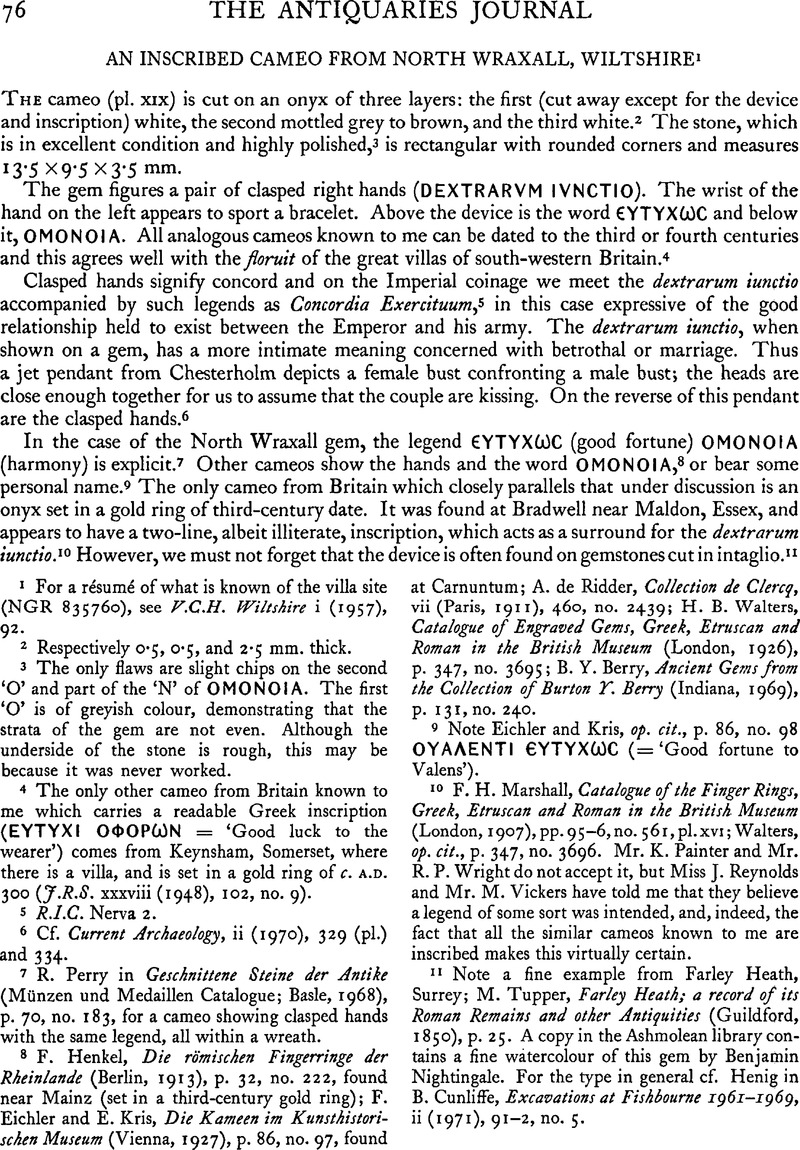No CrossRef data available.
Article contents
An Inscribed Cameo from North Wraxall, Wiltshire1
Published online by Cambridge University Press: 29 November 2011
Abstract

- Type
- Notes
- Information
- Copyright
- Copyright © The Society of Antiquaries of London 1973
References
page 76 note 2 Respectively 0.5, 0.5, and 2–5 mm. thick.
page 76 note 3 The only flaws are slight chips on the second ‘O’ and part of the ‘N’ of ΟΜΟΝΟΙΑ. The first ‘O’ is of greyish colour, demonstrating that the strata of the gem are not even. Although the underside of the stone is rough, this may be because it was never worked.
page 76 note 4 The only other cameo from Britain known to me which carries a readable Greek inscription (ΕϒΤϒΧΙ ΟΦΟΡωΝ = ‘Good luck to the wearer’) comes from Keynsham, Somerset, where there is a villa, and is set in a gold ring of c. a.d. 300 (J.R.S. xxxviii (1948), 102, no. 9Google Scholar).
page 76 note 5 R.I.C.Nerva 2.
page 76 note 6 Cf. Current Archaeology, ii (1970), 329 (pl.) and 334Google Scholar.
page 76 note 7 Perry, R. in Geschnittene Steine der Antike (Münzen und Medaillen Catalogue; Basle, 1968), p. 70, no. 183Google Scholar, for a cameo showing clasped hands with the same legend, all within a wreath.
page 76 note 8 Henkel, F., Die römischen Fingerringe der Rheinlande (Berlin, 1913), p. 32Google Scholar, no. 222, found near Mainz (set in a third-century gold ring); Eichler, F. and Kris, E., Die Kameen im Kunsthistori-schen Museum (Vienna, 1927), p. 86Google Scholar, no. 97, found at Carnuntum; de Ridder, A., Collection de Clercq, vii (Paris, 1911), 460Google Scholar, no. 2439; Walters, H. B., Catalogue of Engraved Gems, Greek, Etruscan and Roman in the British Museum (London, 1926), p. 347Google Scholar, no. 3695; Berry, B. Y., Ancient Gems from the Collection of Burton T. Berry (Indiana, 1969), p. 131, no. 240Google Scholar.
page 76 note 9 Note Eichler and Kris, op. cit., p. 86, no. 98 ΟϒΑΛΕΝΤΙ ΕϒΤϒΧωⲤ (=‘Good fortune to Valens’).
page 76 note 10 Marshall, F. H., Catalogue of the Finger Rings, Greek, Etruscan and Roman in the British Museum (London, 1907), pp. 95–6, no. 561, pl. xvi; Walters, op. cit., p. 347, no. 3696. Mr. K. Painter and Mr.R. P. Wright do not accept it, but Miss J. Reynolds and Mr. M. Vickers have told me that they believea legend of some sort was intended, and, indeed, the fact that all the similar cameos known to me are inscribed makes this virtually certain.Google Scholar
page 76 note 11 Note a fine example from Farley Heath, Surrey; Tupper, M., Farley Heath; a record of its Roman Remains and other Antiquities (Guildford, 1850), p. 25Google Scholar. A copy in the Ashmolean library contains a fine watercolour of this gem by Benjamin Nightingale. For the type in general cf. Henig in Cunliffe, B., Excavations at Fishbourne 1961–1969, ii (1971), 91–2, no. 5Google Scholar.
page 77 note 1 Cf. my list in Antiq. Journ. 1 (1970), 339Google Scholar. Since then I have seen a glass cameo from Colchester depicting a nereid on a dolphin, and an illustration of an onyx cameo from St. Leonard's Forest, Sussex, showing two cupids leaning on torches (Sussex Arch. Collections, XXV (1873), 229–30 (fig.))Google Scholar.


